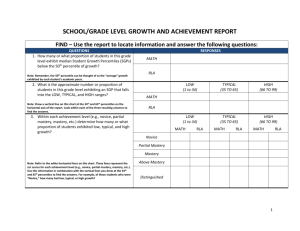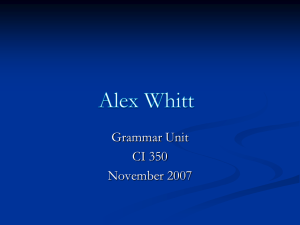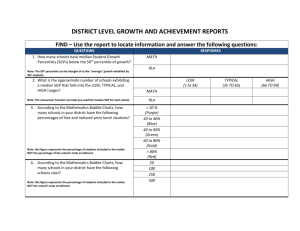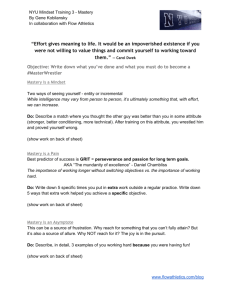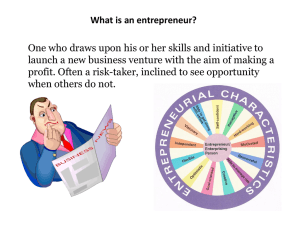Differentiated Instruction - West Virginia Department of Education
advertisement
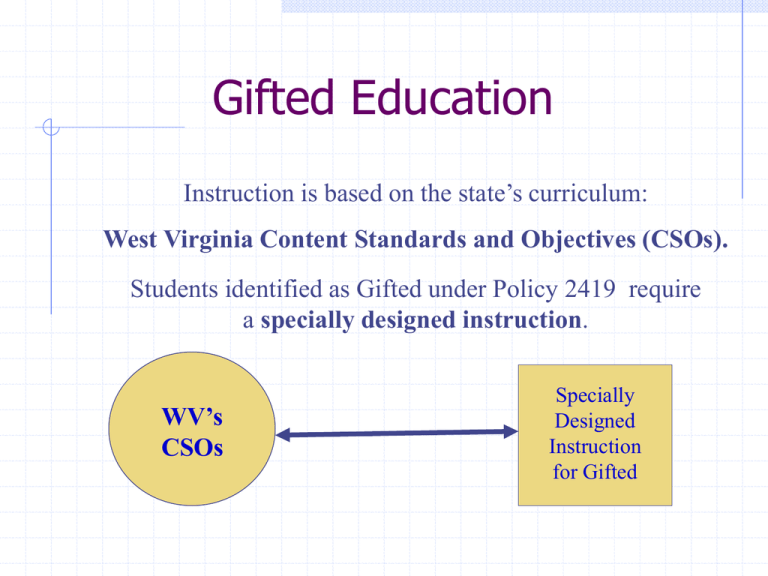
Gifted Education Instruction is based on the state’s curriculum: West Virginia Content Standards and Objectives (CSOs). Students identified as Gifted under Policy 2419 require a specially designed instruction. WV’s CSOs Specially Designed Instruction for Gifted CONTENT STANDARDS AND OBJECTIVES (CSOs) States must align core academic courses to essential state and national standards. The CSOs establish the general curriculum. Revised CSOs Better prepared students for the demands of the 21st Century. Performance Descriptors SS.PD. 5.5 (PREVIOUSLY) Distinguished The student demonstrates exceptional and exemplary performance with distinctive and sophisticated application of knowledge and skills that exceeds the standard in history. Above Mastery The student demonstrates competent and proficient performance and shows a thorough and effective application of knowledge and skills that exceeds the standard in history. Mastery The student demonstrates fundamental course or grade level knowledge and skills by showing consistent and accurate academic performance that meets the standard in history. Partial Mastery The student demonstrates basic but inconsistent performance of fundamental knowledge and skills characterized by errors and/or omissions in history. Performance needs further development. Novice The student demonstrates substantial need for the development of fundamental knowledge and skills, characterized by fragmented and incomplete performance in history. Performance needs considerable development. Grade 5 Social Studies Standard: 5 History SS.S.5.5 Students will organize, analyze and compare historical events, distinguish cause-effect relationships, theorize alternative actions and outcomes, and anticipate future application (Chronology). use the processes and resources of historical inquiry to develop appropriate questions, gather and examine evidence, compare, analyze and interpret historical data (Skills and Application). examine, analyze and synthesize historical knowledge of major events, individuals, cultures and the humanities in West Virginia, the United States and the world (Culture and Humanities). use historical knowledge to analyze local, state, national and global interdependence (Interpretation and Evaluation). examine political institutions and theories that have developed and changed over time; and research and cite reasons for development and change (Political Institutions). Performance Descriptors (SS.PD.5.5) Distinguished Above Mastery Mastery Partial Mastery Novice Students evaluate the significance of people, places, documents, ideas and events in their correct historical period and context from the Post-Revolutionary Era to the present. Students prioritize events that led to the ascent of the United States to a world power and evaluate the role of the United States in significant 19th and 20th century events. Students research and explain the significance of people, places, documents, ideas and events in their correct historical period and context from the Post-Revolutionary Era to the present. Students compare and contrast events that led to the ascent of the United States to a world power and explain the role of the U.S. in significant 19th and 20th century event Students explain the significance of people, places, documents, ideas and events in their correct historical period and context from the PostRevolutionary Era to the present. Students examine events that led to the ascent of the United States to a world power and explain the role of the United States in significant 19th and 20th century events. Students identify the significance of people, places, documents, ideas and events in their correct historical period and context from the PostRevolutionary Era to the present. Students recognize events that led to the ascent of the United States to a world power and discuss the role of the United States in significant 19th and 20th century events. Students arrange a list of the significant people, places, documents, ideas and events in their correct historical period and context from the PostRevolutionary Era to the present. Students label events that led to the ascent of the United States to a world power and define the role of the United States in significant 19th and 20th century events. Objectives Students will SS.O.5.5.1 Analyze the events and the historic figures responsible for such documents as the United States Constitution, the Bill of Rights and the Emancipation Proclamation. SS.O.5.5.2 Create a timeline showing the arrival of major immigrant groups and describe their experiences and influence upon American society using primary source documents. SS.O.5.5.3 Describe the development of transportation in the United States and explain its impact on settlement, industry and residential patterns. SS.O.5.5.4 Explain why maintaining historical records and landmarks is important to the United States. SS.O.5.5.5 Interpret quotes of famous Americans from various periods of history. SS.O.5.5.6 Research important figures and their reactions to events and judge their significance to the history of our democracy (e.g., George Washington, Thomas Jefferson, Abraham Lincoln, Sojourner Truth, Susan B. Anthony, Eleanor Roosevelt and Martin Luther King, Jr.). SS.O.5.5.7 Evaluate the contributions of regional folk heroes and other popular figures and judge the significance of those contributions to the cultural history of the United States (e.g., frontiersmen such as Daniel Boone, cowboys, mountain men such as Jedediah Smith, American Indian Chiefs including Geronimo and outlaws such as Billy the Kid.) SS.O.5.5.8 (Etc.) Grade 3 Listening, Speaking and Media Literacy Standard 3: Listening, Speaking and Media Literacy RLA.S.3.3 Students will apply listening, speaking and media literacy skills and strategies to communicate with a variety of audiences and for different purposes. Performance Descriptors RLA.PD.3.3 Distinguished Above Mastery Mastery Partial Mastery Novice Third grade students at the distinguished level in listening, speaking and media literacy recognize, exhibit and use correct grammar in oral communication skills in order to deliver recitations. They listen to and explain topics presented through a variety of media. They create a media product that demonstrates format and purpose. Third grade students at the above mastery level in listening, speaking and media literacy listen and respond to different literary forms by paraphrasing information, recounting personal experiences and supporting opinions. They identify the intended audience and distinguish a variety of messages conveyed by visual media. Students adjust their speaking rate and react to an audience when communicating. They create a presentation for a specific purpose using two or more forms of technology. Third grade students at the mastery level in listening, speaking and media literacy listen and respond to different literary forms by summarizing information and extending a story using their imagination. They distinguish messages conveyed through visual media such as television and the internet. Students create a presentation using a form of technology. Third grade students at the partial mastery in listening, speaking and media literacy recite and comprehend songs, stories, and poems by describing story elements and role-playing scenes. They describe the main idea of weather reports or newspaper photos. Students create an oral or visual presentation using media tools. Third grade students at the novice level in listening, speaking and media literacy listen and respond to stories and poems by retelling and relating the information to their own lives. They determine the main idea of cartoons and photos. Students relate a real or imagined story orally or by creating a picture or poster. Objectives Students will RLA.O.3.3.01 listen and respond to familiar stories and poems (e.g., summarize and paraphrase to confirm comprehension, recount personal experiences, imagine beyond the literary form). RLA.O.3.3.02 distinguish different messages conveyed through visual media (e.g., photos, television, multimedia Internet). RLA.O.3.3.03 create an age appropriate media literacy product that reflects understanding of format and characteristics. portaportal.com - guest login vmohnack http://wvde.state.wv.us Teachers CSOs Word Version On-Line Searchable Teach 21 Power Standards Instructional Guides (Plan format) Understanding By Design (UBD) 1. Identify desired results (what the student will know) 2. Determine acceptable evidence (how will the student demonstrate knowledge) 3. Plan instruction; Implement the design Teach 21 http://wvde.state.wv.us Teachers; Teach 21; Instructional Guides http://wvde.state.wv.us/ose/Gifted/Gifted.htm Kindergarten RLA.O.K.2.01 develop proper manuscript techniques in print: correct directionality proper writing positions print upper/lower case letters and numerals first and/or last name uniformity First Grade Second Grade Third Grade RLA.O.1.2.01 demonstrate proper manuscript techniques: correct directionality, proper writing position, print upper/lower case letters of the alphabet and numerals RLA.O.1.2.03 develop a simple story with appropriate sequence (e.g., beginning, middle, end). RLA.O.2.2.01 demonstrate proper manuscript and begin use of cursive writing techniques: posture paper placement pencil grip letter formation letter size RLA.O.2.2.03 develop a story with proper sequence (e.g., beginning-middleend, containing a main idea, supporting details). RLA.O.3.2.01 demonstrate proper manuscript and full transition to cursive writing techniques: posture paper placement pencil grip letter formation slant letter size spacing alignment RLA.O.3.2.04 develop proper paragraph form in written composition: beginning, middle, end main ideas with relevant details sentence variety such as declarative, interrogative and exclamatory and imperative Fourth Grade Fifth Grade RLA.O.4.2.01 demonstrate proper manuscript and cursive writing techniques: legibility uniformity in all written work RLA.O.4.2.05 develop proper form in written composition: beginning-middleend indentation topic sentence introductory and concluding paragraphs related details transitional and descriptive words RLA.O.5.2.03 from a prompt, use the writing process to develop a 3-5 paragraph composition with an introductory paragraph, supporting detail paragraph(s), and concluding paragraph that incorporates specific, relevant details. http://wvde.state.wv.us/ose/Gifted/Gifted.htm Sixth Grade Seventh Grade Eighth Grade Ninth Grade Tenth Grade Eleventh Grade Twelfth Grade RLA.O.6.2.03 from a prompt, use the writing process to develop a composition that contains specific, relevant details and transitions. RLA.O.7.2.05 from a prompt use the five-step writing process to develop a focused composition that contains specific, relevant details and vivid and precise words. RLA.O.8.2.05 from a prompt use the five-step writing process to develop a focused composition that contains specific, relevant details and vivid and precise words. RLA.O.9.2.01 compose narrative, informative, descriptive, persuasive writing from a prompt using the five-step writing process (pre-writing, drafting, revising, editing, publishing). RLA.O.10.2.01 define topic from assigned subject/prompt and compose narrative, informative, descriptive and persuasive writings using the five-step writing process (prewriting, drafting, revising, editing publishing) for specific audiences by employing writing strategies that are modeled in various types of literature. RLA.O.11.2.01 employ the fivestep writing process (prewriting, drafting, revising, editing, publishing) for developing narrative, informative, descriptive, persuasive and functional writings that include a letter of job application, a scholarship application/essay, and personal letters. RLA.O.12.2.01 compose using the five-step writing process (pre-writing, drafting, revising, editing, publishing), critique and evaluate narrative, informative, descriptive, persuasive and functional writings that include a letter of job application, a scholarship application/essa y, and personal letters. Understanding By Design (UBD) 1. Identify desired results (what the student will know) 2. Determine acceptable evidence (how will the student demonstrate knowledge) 3. Plan instruction; Implement the design Assessment Jacob’s Skill Ladders Jacob’s Ladder A Questions inserted here. Cause and Effect A 2 A 1 Questions inserted here. Sequencing Questions inserted here. Title of Reading Selection A 3 Consequences and Implications Jacob’s Skill Ladders Jacob’s Ladder B Questions inserted here. Category/Classification B 2 B 1 Questions inserted here. Details/Examples Questions inserted here. Title of Reading Selection B 3 Generalization Jacob’s Skill Ladders Jacob’s Ladder C Questions inserted here. Evidence/Inference C 2 C 1 Questions inserted here. Context/Setting/Characterization Questions inserted here. Title of Reading Selection C 3 Main Idea/Theme Jacob’s Skill Ladders Jacob’s Ladder D Questions inserted here. Summarizing D 2 D 1 Questions inserted here. Paraphrasing Questions inserted here. Title of Reading Selection D 3 Creative Synthesis Delilah She has blue eyes like the ocean. Her tongue like a rose. Her nose like a heart. Her tail like a fan. Her black coat like the night sky. By Casey Carroll Grades 4-5 Honorable Mention Center for Gifted Education Talent Search Theme/Concept C 3 Write a poem like Delilah to describe your pet or an animal you know. (Use the poem as your model.) Evidence/Inference What evidence is important in deciding on Delilah’s identity? What or who is Delilah in the poem, based on the evidence? Characterization C 1 What words does the poet use to show Delilah as a lovable creature? Delilah C 2 The Crow and the Pitcher A crow, dying of thirst, came upon a pitcher which had once been full of water. When the crow put his beak into the mouth of the pitcher, he found that only very little water was left in it, and he could not reach far enough down to get at it. He tried and tried, but at last had to give up in despair. Then a thought came to him. He took a pebble and dropped it into the pitcher. Then he took another pebble and dropped it into the pitcher. Then he took another pebble and dropped it into the pitcher. At last he saw the water rising toward him, and after casting a few more pebbles into the pitcher, he was able to drink and save his life. Consequences and Implications A 3 What would have happened if the crow had done the following: a) b) c) d) Kept putting his beak in the bottle? Flown away? Broken the bottle? Waited for rain? A 2 What caused the water to reach the crow? What overall effect did it have on the crow? Sequencing What steps did the crow use to get water? Outline them below A 1 in order: 1. _________________ 2. _________________ 3. _________________ 4. _________________ The Crow and the Pitcher Cause and Effect Main Idea/Theme What main idea(s) did you get from this story? Inference C 2 What made the crow successful in getting a drink of water? Why did his plan work? Characterization C 1 What are the crow’s most important qualities? What other characters have you read about that show similar life qualities? How were their situations similar or different from the crow’s situation? The Crow and the Pitcher C 3 Assessment/Response Form A3 B3 C3 D3 Circle One: A2 B2 C2 D2 Circle One: A1 B1 C1 D1 Circle One: Crows get thirsty. Crows are smart. The crow kept putting pebbles in the water until it could drink. I didn’t even know that. Student Score: 0 1 2 Teacher Score: 0 1 2 The crow was successful because when you put the pebbles in the water, the water came up. That helped him to get water. He had to get pebbles and keep doing that until water came up. Student Score: 0 1 2 Teacher Score: 0 1 2 There’s not a book I read about that was similar to this one. The crow’s most important qualities are water and food. Student Score: 0 1 2 Teacher Score: 0 1 2 Scoring: 0 = Needs Improvement 1 = Satisfactory 2 = Exceeds Expectations Students score their work in the top part of the scoring box. Teachers score the work in the bottom part of the scoring box. Student Comments: Is there anything you would like your teacher to know about your work on this reading? Teacher Comments: Selection Title: ________________________________________________________ Name:____________________________________________ Date: ____________ Benefits of Curriculum-Based Assessment Targets high level skills; performance-based assessments require students to operate at higher levels of application, synthesis, analysis and evaluation Allows for students to show depth and complexity through task assignment Conveys higher level expectations for student performance Allows the teacher to collect data and monitor student performance over time Complements standardized testing through student demonstration Works more efficiently as a tool to examine students’ mastery in an area Literature Web Key Words Feelings READING Ideas Images/Symbols Structure Reading Web Key Words: What were some words and phrases that were especially interesting or important? What words were new to you? Feelings: What feelings did you get reading the passage? What feelings did the characters have? How were those feelings expressed? Ideas: What was the main idea? What other major ideas and concepts were important? What was the author trying to say about those ideas? Images/Symbols: How did the author use description and imagery in the novel? What sensory images came to your mind? How did the author use symbols? Structure: What literary and style elements did the author use? How did the structure of the writing contribute to the meaning of the novel? (check spaces, format, use of punctuation, repetition of words, metaphors) Elements of Reasoning Purpose/ Goal Point of View Evidence/ Data Assumptions Issue/ Problem Concepts/ Ideas Inferences Implications/ Consequences -- Paul, 1992 Reasoning in Literature Adapt to Grade Level Purpose/Goal Point of View What is the purpose of the poem or story? Why do you think this? What point of view is the poem or story from? Explain why you think this is so? Evidence/Data Implications/Consequences What are the implications of character behavior at certain points in the story? Cite examples that will support your answers. Issue/Problem What is the central issue of the poem or story? Inferences What evidence is presented that the central character is motivated by a given emotion? How does the evidence or data contribute to the central issue of the poem or story? Concepts/Ideas What concepts are central to understanding the story? What do we understand about these concepts? For example, what generalizations about the concept of change can be made about the poem or story? What inferences might be made about the ending of the poem or story based on specific events? Assumptions What assumptions does the author make about the concept of change? What in the poem or story led you to your answer? Assessment Lexiles http://www.lexile.com/EntrancePageHtml.aspx?1 Quantiles http://www.quantiles.com/ Assessment Acuity http://www.ctb.com/products/product_su mmary.jsp?FOLDER%3C%3Efolder_id=1 408474395292638 Assessment Performance-Based http://school.discoveryeducation.com/ schrockguide/assess.html 212 Degrees Video Understanding By Design (UBD) 1. Identify desired results (what the student will know) 2. Determine acceptable evidence (how will the student demonstrate knowledge) 3. Plan instruction; Implement the design Differentiated Instruction Differentiation is providing gifted students with different options than those offered to their classroom peers for acquiring content, processing ideas, and developing products (Tomlinson, p.3) • Content – more depth and complexity • Process – flexible in learning styles • Product – creative and performancebased Differentiated Instruction Enrichment – instruction that allows the student to study content more broadly or in greater depth. It goes beyond fundamental knowledge and skills and provides opportunities for critical thinking. Acceleration – instruction that allows the individual student to master content at a faster or earlier rate at grade level either horizontally or vertically across grade levels. Developing Advanced Skills Advanced Content Products/ Processes Major Concepts/ Generalizations VanTassel-Baska, 1986 Differentiated Instruction Teachers must have a deep understanding of the state’s content standards in order to explore the Vertical Alignment – across grade levels for individual acceleration of content; and Horizontal Alignment - within a single grade level for the needed depth and breadth of content. Standards Comparison Regular Classroom Language Arts Emphasis Gifted Classroom Language Arts Emphasis Basic reading skills and phonemic awareness Story selections at higher levels of readability Focus on plot, setting, character and other basic story elements Focus on motivation, theme, and other abstract literary elements Comprehension and understanding questions Study of main ideas of a story or novel Questions regarding implications, consequences, and the synthesis and evaluation of literature selections Study of concepts and themes within and across different genres Grade 5 Social Studies Standard: 5 History SS.S.5.5 Students will organize, analyze and compare historical events, distinguish cause-effect relationships, theorize alternative actions and outcomes, and anticipate future application (Chronology). use the processes and resources of historical inquiry to develop appropriate questions, gather and examine evidence, compare, analyze and interpret historical data (Skills and Application). examine, analyze and synthesize historical knowledge of major events, individuals, cultures and the humanities in West Virginia, the United States and the world (Culture and Humanities). use historical knowledge to analyze local, state, national and global interdependence (Interpretation and Evaluation). examine political institutions and theories that have developed and changed over time; and research and cite reasons for development and change (Political Institutions). Performance Descriptors (SS.PD.5.5) Distinguished Above Mastery Mastery Partial Mastery Novice Students evaluate the significance of people, places, documents, ideas and events in their correct historical period and context from the Post-Revolutionary Era to the present. Students prioritize events that led to the ascent of the United States to a world power and evaluate the role of the United States in significant 19th and 20th century events. Students research and explain the significance of people, places, documents, ideas and events in their correct historical period and context from the Post-Revolutionary Era to the present. Students compare and contrast events that led to the ascent of the United States to a world power and explain the role of the U.S. in significant 19th and 20th century event Students explain the significance of people, places, documents, ideas and events in their correct historical period and context from the PostRevolutionary Era to the present. Students examine events that led to the ascent of the United States to a world power and explain the role of the United States in significant 19th and 20th century events. Students identify the significance of people, places, documents, ideas and events in their correct historical period and context from the PostRevolutionary Era to the present. Students recognize events that led to the ascent of the United States to a world power and discuss the role of the United States in significant 19th and 20th century events. Students arrange a list of the significant people, places, documents, ideas and events in their correct historical period and context from the PostRevolutionary Era to the present. Students label events that led to the ascent of the United States to a world power and define the role of the United States in significant 19th and 20th century events. Objectives Students will SS.O.5.5.1 Analyze the events and the historic figures responsible for such documents as the United States Constitution, the Bill of Rights and the Emancipation Proclamation. SS.O.5.5.2 Create a timeline showing the arrival of major immigrant groups and describe their experiences and influence upon American society using primary source documents. SS.O.5.5.3 Describe the development of transportation in the United States and explain its impact on settlement, industry and residential patterns. SS.O.5.5.4 Explain why maintaining historical records and landmarks is important to the United States. SS.O.5.5.5 Interpret quotes of famous Americans from various periods of history. SS.O.5.5.6 Research important figures and their reactions to events and judge their significance to the history of our democracy (e.g., George Washington, Thomas Jefferson, Abraham Lincoln, Sojourner Truth, Susan B. Anthony, Eleanor Roosevelt and Martin Luther King, Jr.). SS.O.5.5.7 Evaluate the contributions of regional folk heroes and other popular figures and judge the significance of those contributions to the cultural history of the United States (e.g., frontiersmen such as Daniel Boone, cowboys, mountain men such as Jedediah Smith, American Indian Chiefs including Geronimo and outlaws such as Billy the Kid.) SS.O.5.5.8 Intel www.intel.com/education List documents; rank from most to least in importance in changing U.S. (prioritize) United States Constitution Bill of Rights Emancipation Proclamation (etc.) List important figures and significance to the history of our democracy; rank from most to least in influencing your life (compare and contrast) Visual Ranking Project – Important Figures in … vmohnack Team01 Team 03 Team 05 Team02 Team 04 George Washington Thomas Jefferson Abraham Lincoln Sojourner Truth Susan B. Anthony Eleanor Roosevelt Martin Luther King, Jr. List events that led to the ascent of the United States to a world power; rank the events from most to least in importance (prioritize) Westward Expansion Industrial Revolution Transcontinental Railroad World War I World War II Thinkfinity www.thinkfinity.org Create a timeline showing the arrival of major immigrant groups and describe their experiences and influence upon American society today. Search word; timeline Interactive Timeline SASinSchools http://wvde.state.wv.us/sas Interactive activities Social Studies United States History; Modern America Standard Oil Monopoly (wvlearner) Thinkfinity http://wvde.state.wv.us search/explore rough draft of plan Choose what you want the student to learn. Decide how the student will demonstrate. Plan instruction. Intel http://wvde.state.wv.us Teachers Plan format Think.com October 10th http://wvde.state.wv.us Teachers Plan format Quote to Note "The illiterate of the 21st century will not be those who cannot read and write, but those who cannot learn, unlearn, and relearn." Alvin Toffler, American futurist Meet Me At The WEBTOP http://wvde.k12.wv.us Resources Tomlinson, Carol Ann (1995). How to Differentiate Instruction in Mixed-Ability Classrooms. Alexandria, VA: Association for Supervision and Curriculum Development. Van Tassel-Baska, Joyce (2003) Content-Based Curriculum for High-Ability Learners. Washington, D.C.: A Service Publication of The National Association for Gifted Children McTighe and Williams (2004) Understanding by Design. Alexandria, VA: Association for Supervision and Curriculum Development.
